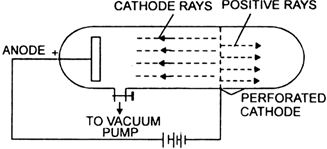
The nature of positive rays produced in a vacuum discharge tube depends upon:
(A) The nature of gas filled
(B) Nature of the material of cathode
(C) Nature of the material of anode
(D) The potential applied across the electrodes
Answer
468k+ views
1 likes
Hint: Positive rays are the beam of positive ions produced from the anode (which is positively charged electrode) in a vacuum discharge tube within a gas filled discharge tube under low pressure and high voltage.
Complete step by step answer:
-The positive rays also known as canal rays which are positively charged rays obtained from the gas molecule by removing the electrons. Positively charged rays depend only upon the nature of gas filled in the discharge tube and cannot exist without the gas present in the discharged tube.
The apparatus of this diagram shown in the following diagram –

-Positive rays originate from anode and are directed toward the cathode which is a negatively charged electrode. These rays are mainly formed due to the ionisation of gas present in the discharge tube.
-A very high voltage is applied across the electrode which is required for the formation of these rays because ionisation of gases is possible under high pressure. But the nature of positive rays does not depend upon the applied potential across the electrode.
-Low pressure inside the discharge tube allows the free movement of positively charged ions inside the discharge tube. So when the potential is applied the charge ion collides with a gas atom and knocks off the electrons and makes more positive ions. These positive ions produce more bombardment with gas molecules and this continuous chain reaction forms a beam of positive ions. The correct answer is option “A” .
Note: Do not confuse canal rays with cathode rays. Canal rays and cathode rays are opposite to each other. The cathode rays are a beam of electrons that travels away from the cathode and towards the anode, while canal rays move in the exact opposite direction.
Complete step by step answer:
-The positive rays also known as canal rays which are positively charged rays obtained from the gas molecule by removing the electrons. Positively charged rays depend only upon the nature of gas filled in the discharge tube and cannot exist without the gas present in the discharged tube.
The apparatus of this diagram shown in the following diagram –

-Positive rays originate from anode and are directed toward the cathode which is a negatively charged electrode. These rays are mainly formed due to the ionisation of gas present in the discharge tube.
-A very high voltage is applied across the electrode which is required for the formation of these rays because ionisation of gases is possible under high pressure. But the nature of positive rays does not depend upon the applied potential across the electrode.
-Low pressure inside the discharge tube allows the free movement of positively charged ions inside the discharge tube. So when the potential is applied the charge ion collides with a gas atom and knocks off the electrons and makes more positive ions. These positive ions produce more bombardment with gas molecules and this continuous chain reaction forms a beam of positive ions. The correct answer is option “A” .
Note: Do not confuse canal rays with cathode rays. Canal rays and cathode rays are opposite to each other. The cathode rays are a beam of electrons that travels away from the cathode and towards the anode, while canal rays move in the exact opposite direction.
Latest Vedantu courses for you
Grade 11 Science PCM | CBSE | SCHOOL | English
CBSE (2025-26)
School Full course for CBSE students
₹41,848 per year
Recently Updated Pages
Master Class 9 General Knowledge: Engaging Questions & Answers for Success

Master Class 9 English: Engaging Questions & Answers for Success

Master Class 9 Science: Engaging Questions & Answers for Success

Master Class 9 Social Science: Engaging Questions & Answers for Success

Master Class 9 Maths: Engaging Questions & Answers for Success

Class 9 Question and Answer - Your Ultimate Solutions Guide

Trending doubts
State and prove Bernoullis theorem class 11 physics CBSE

Who built the Grand Trunk Road AChandragupta Maurya class 11 social science CBSE

1 ton equals to A 100 kg B 1000 kg C 10 kg D 10000 class 11 physics CBSE

State the laws of reflection of light

One Metric ton is equal to kg A 10000 B 1000 C 100 class 11 physics CBSE

Difference Between Prokaryotic Cells and Eukaryotic Cells




